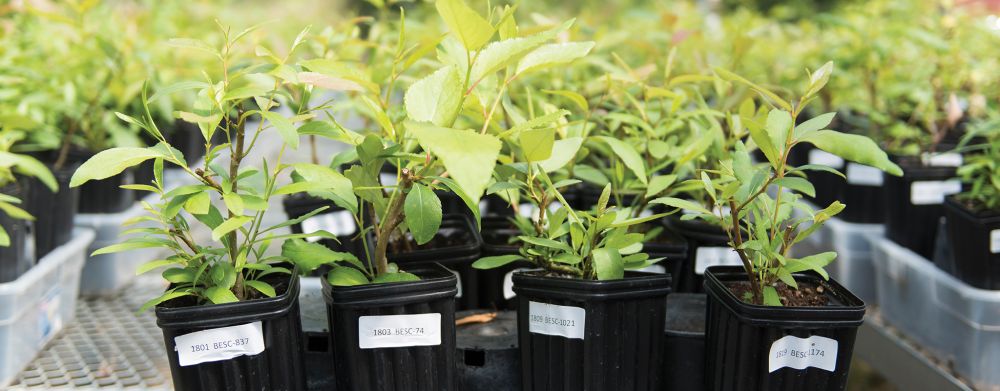
Steve Strauss, Oregon State University distinguished professor of forest biotechnology, focuses his attention on genetic engineering and the modification of genes in trees used in plantation forestry and horticulture. He’s also Director of the GREAT TREES research cooperative, which researches genetic technology to make state-of-the-art advancements in basic methods for genetic modification of forest trees.
“GREAT stands for Genetic Research on Engineering and Advanced Transformation of Trees,” Strauss says. “Meaning how we can learn to efficiently modify or insert genes in the important, but often very biologically difficult, trees critical to the global forest industry.”
Most of the GREAT TREES members are major forestry companies worldwide that grow trees like eucalypts as significant pulp and energy sources.
Strauss’ goal is to create major advances in how genes are put into tree cells to modify or insert new functions, and then regenerate those cells into healthy trees with desired properties like pest resistance, better wood for specific purposes, or improved social acceptability. For example, trees that are improved for industrial uses but will not spread into wild populations should find wider acceptance.
“This work,” Strauss says, “requires a basic understanding of how plants naturally develop their embryos and shoots, and using that knowledge to help prod the cells to do what you want them to.”
Recently, Strauss’ published research from field trials at OSU that showed that poplar could be genetically modified to reduce negative impacts on air quality while leaving their growth virtually unchanged.
Poplars are fast-growing trees that are a source of biofuel and other products, including paper, pallets, plywood and furniture frames. These trees are also a significant isoprene producer, the critical component of natural rubber, and a pre-pollutant. Poplar and other trees, including oak, eucalyptus and conifers, produce isoprene in their leaves in response to climate stress, such as high temperatures. Increases in isoprene negatively affect regional air quality and lead to higher atmospheric aerosol production levels, more ozone in the air, and longer methane life. Ozone and methane are greenhouse gases, and ozone is a respiratory irritant.
The findings, published in the Proceedings of the National Academy of Sciences, are important because poplar plantations cover 9.4 million hectares globally – more than double the land used 15 years ago. A research collaboration led by scientists at the University of Arizona, the Institute of Biochemical Plant Pathology in Germany, Portland State University and OSU participated in this work.
“As the world faces increasing challenges to keep forests productive and healthy given new pests and rapid climate change, companies are looking to all the technologies for help, and genetic modification is a big option,” Strauss says.
There are barriers to pursuing gene modification work, however. First, says Strauss, it is complicated and expensive work, which is where GREAT TREES research cooperative comes in. The second barrier is fear and distrust.
“The public has been educated to fear modern genetic modification across the board, so regulations and market restrictions are very stringent,” Strauss says. “In many cases, the restrictions are impossible obstacles for even the largest companies to deal with as common market restrictions exclude any possibility for research with genetically modified trees in their forests or products.”
One part of GREAT TREES’ work, albeit a small part, says Strauss, is to try and influence policy and regulations about genetic modification of trees and crops to make them much more science-based and research-friendly.
“If something is GMO, it’s guilty until proven safe in the minds of many and in our regulations today,” he says. “These technologies are new tools that require scientific research to evaluate and refine them on a case-by-case basis. Blanket exclusions go against international scientific consensus. We have a huge need for expanded production of sustainable and renewable forest products and ecological services, and biotechnologies can help meet that need.”
Over the past few years, Strauss has received around $4 million in funding from the National Science Foundation to develop new phenomic and genomic insights into genetic diversity in the capacity for regeneration of new shoots and roots in poplar. In short, phenomics means to take data on plant growth in a precise, rapid, and computer-assisted manner. Genomics is the same idea, but applied to large-scale determination of DNA sequences.
Working with professor Fuxin Li in the School of Electrical Engineering and Computer Science at OSU, Strauss and his team have created and submitted for publication a new annotation tool, using machine learning, to enable researchers to rapidly and precisely code images of plant material. These data are then used in machine vision models to estimate regeneration rates in thousands of samples used in genetic analysis. Work at this scale was previously not possible using existing techniques. So far, they have completed and edited machine vision-derived data for two regeneration experiments involving about 1,300 replicated genotypes each, and a third experiment is nearly complete and another one starting up.
“After years of work to develop and test our phenomic systems, then apply them to quantify regeneration rates in literally tens of thousands of stems and Petri dishes containing wild black cottonwood plants whose genomes were previously sequenced, we are poised to identify some of the major genes that affect the capacity for regeneration of shoots, roots and modified tissues from single cells,” Strauss says. “It will be an exciting next couple of years for our laboratory.”
This story was part of the College of Forestry’s 2019-2020 Biennial Report.

